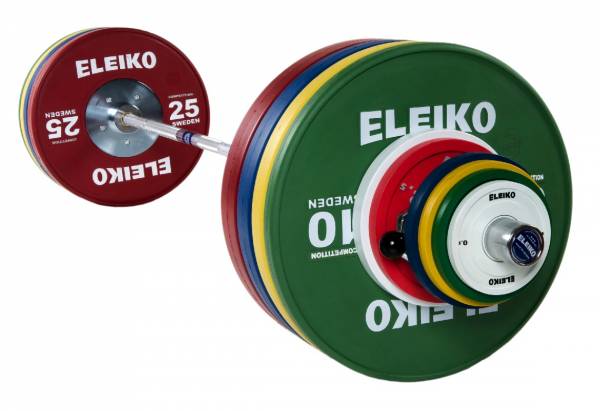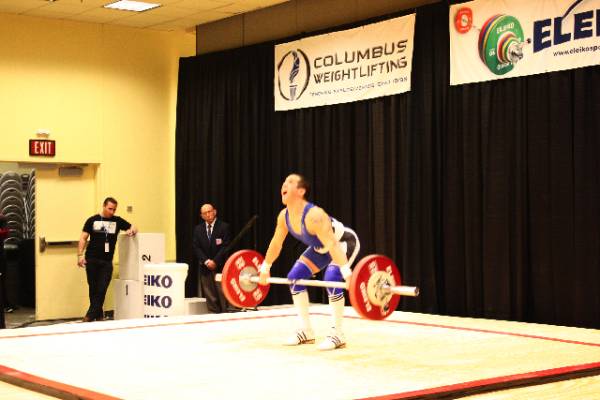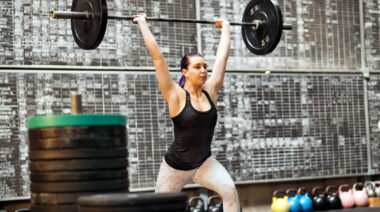“Less freakout, more lockout.” – Peter Curcio
The other night my masters lifter Dave was setting up for a snatch attempt that would match his personal record. It had been a while since he’d gone for this lift as he’d focused most his energy on squats lately. He grabbed the bar, hook gripped, set himself, and exploded the bar off the platform.
He was particularly explosive that night. The bar was just flying. And that was the problem. Or rather, Dave’s not knowing that he would be that powerful was the problem.
Dave is an odd duck – in a good way. He’s 42 years old, yet he’s by far the most mobile lifter in my gym. He’s got some of the best technique. He is strong. And he has absolutely no fear of getting down under a heavy weight. When that bar goes up, Dave goes down – fast!
So that night, as he exploded the bar up at a faster than normal rate, he dove down under it with his abnormally fast speed into the hole. He was so fast that he beat the bar down to the bottom. This caused the bar to crash on him, or rather crash into his hands, and the force of all that weight broke his lockout (caused his arms to bend).
The bar descended like it had a grudge and was hungry for blood. It crunched through his lockout, bent his arms, and slammed into the back of his neck. It forced Dave forward at breakneck speed, his face shoved forward toward the platform, and there was nothing anyone could to do stop it.
Dave, being the nimble creature he is, wasn’t fazed by this turn of events. He twisted his body, rolled with the punch, and was able to release his head from the ensuing disaster at the last second before his teeth met hardwood.
He was safe.
Laughter Is The Best Medicine
I immediately – after the worst was clearly over – started laughing at the top of my lungs. I did this for three reasons:
- I knew Dave wasn’t hurt.
- I know Dave well, and knew he would also find this funny.
- I needed the new lifters in the gym to know that this wasn’t the end of the world.
When a child skins their knee and you respond by asking, “Oh, no! Are you okay? That really looks like it hurts!” The kid is very likely to start crying. If instead you make light of the situation then (so long as the injury isn’t all that bad) the kid will very often join you in making light of it.
Adults are a lot like kids.
 When Dave got up he joined me in the laughing and we all have been making jokes about it ever since. While the situation did scare some of the newer lifters, the fact that Dave laughed it off and then went so far as to take the lift again ten minutes later impressed them enough to have faith that he was okay – and by extension, they’d be okay.
When Dave got up he joined me in the laughing and we all have been making jokes about it ever since. While the situation did scare some of the newer lifters, the fact that Dave laughed it off and then went so far as to take the lift again ten minutes later impressed them enough to have faith that he was okay – and by extension, they’d be okay.
Dave is hardly the only lifter to ever have this happen to him. In fact, dropping a bar on your back, neck, or head is something that CAN happen and has to many of us (me included). But if you learn a few key things, you can largely avoid this kind of disaster.
The Two Skills You Gotta Have To Avoid Dropping A Bar On Your Head
There are really only two things you need to know to prevent this from happening to you – or at the very least, lower your probability of this happening to you.
ONE: Less Freakout, More Lockout
My business partner, podcast cohost, and lifter at PDX Weightlifting, Peter Curcio has a saying, “Less freakout, more lockout.” It takes seriously that Olympic lifting is, among other things, downright scary sometimes.
No matter how good your technique is with light weights, if your fear gets in the way, you will use crappy technique with heavy weights. Proper technique includes a powerful and massively tight lockout in the catch of the snatch. Your arms need to be so darned rigid that a herd of stegosauruses could stampede into you and you’d still be holding that bar above your head.
The rules of a good lockout are:
- Locked arms (duh!)
- Head forward a bit (that doesn’t necessarily mean you need to look down)
- Shrug up hard
Doing those things will make you far stronger in the overhead position. Being prepared for the zombie apocalypse is all the rage, but don’t forget to be ready for that herd of dinosaurs coming to break your lockout!
TWO: Pull Under, Don’t Drop Under
Coaches lie all the time. “One step at a time” is the mantra. And that means we are forced to have you erring on one side or the other of some arbitrary line. One way we lie to you is by saying your goal is to explode the bar off the hip, then dive to the bottom as fast as possible.
That’s a lie. It’s a useful lie for a number of reasons, though.
If you are like most adult beginners, you have a horrible habit of hitting the hips with the bar and then continuing to pull up on the bar with your arms while the rest of your body remains standing up totally straight! We call that “over pulling.”
 I use the “dive under the bar” lie myself because if you tell a beginner to do anything at all with their arms – anything – they will almost invariably over pull.
I use the “dive under the bar” lie myself because if you tell a beginner to do anything at all with their arms – anything – they will almost invariably over pull.
So, I’ve fixed one problem with my lie. But I’ve created another: When you are in the habit of diving to rock bottom on every single rep, no matter what, then you are increasing your chances of the bar landing on your head.
Let’s use a hypothetical example to understand why. Assume that when you are in the full overhead squat position, the measurement from the floor to the bar is six inches (What? I’m imagining you as a Smurf).
Now let’s imagine that you are ultra-powerful one day – like Dave was – and you explode a PR attempt (heavy!) up to seven inches? Because you listen well, and learned to dive to the bottom when the bar hits your hip, you beat the bar to the bottom and the bar ends up a full inch above your outstretched hands.
This results in a CRASH!
It doesn’t take a full inch of difference to cause a major crash with heavy weights. If you are anything less than dinosaur ready – super locked! – then you are risking the bar landing on your head.
The fix is to catch the bar where it lands. Almost every lift you ever take will put the bar somewhere between a tall power snatch and a full overhead squat. It will be in the large gray area in-between. Your goal is to get very good at learning exactly where the bar is going and meeting the bar there exactly.
 You do this by pulling yourself under the bar, rather than simply diving down to rock bottom on every attempt. When the bar hits your hips, you start to pull yourself down as fast as possible. This puts you in control of the bar at all times. There should NEVER be a time when the bar and you are not in sync.
You do this by pulling yourself under the bar, rather than simply diving down to rock bottom on every attempt. When the bar hits your hips, you start to pull yourself down as fast as possible. This puts you in control of the bar at all times. There should NEVER be a time when the bar and you are not in sync.
Control the bar; don’t let it control you.
Hit the hip. Pull yourself down. Lockout. Save your head…and watch out for dinosaurs.






